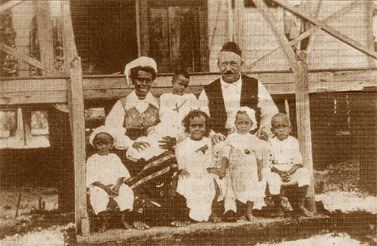The old adage that cats have nine lives might not be true in the technical sense, but there is an undeniable grain of truth in the saying.
Sometimes it feels like a cat can survive anything. Our furry friends are adaptable, athletic, ferocious, and, at times, stubborn, but there is one thing that cats fear above all other things–water.
Well…all cats but one: Unsinkable Sam.


Having a cat on board a ship just makes sense. They are fantastic for keeping the rodent population under control and can provide some much-needed moral support to sailors who have been on the water for months at a time.
But what happens to these faithful sea-faring felines when the ship goes down?
Here, we’ll tell the story of the infamous, adorable Unsinkable Sam and how those hypothetical nine lives, sheer luck, or just the compassion of sailors may have saved him three times over.
Was Unsinkable Sam Real?
Before we dive into the thrilling tale of World War II’s famous naval cat, we have to answer an important question: was Unsinkable Sam a real cat?
Some sources suggest that Sam was just an entertaining story passed around from ship to ship during the war, while others claim that the tale of Unsinkable Sam was actually the story of two cats merged into one exciting narrative.
The supposed pictures of Unsinkable Sam that we have available do picture two different cats, but there’s also no concrete proof that those photos were actually of Sam himself.
The most compelling argument for Sam’s existence is that he is mentioned in the Royal Navy’s archives, which state, “Oscar, the Bismark’s cat, finished his days at the Home for Sailor’s in Belfast around 1955.”
The Bismarck
It is fascinating to think about what Sam’s life must have been like before he embarked on his sea-faring adventures.
Unfortunately, we don’t know much about his past, except that he came from Germany, and his first ship was the German battleship Bismarck. It is possible that his owner was a member of the Kriegsmarine or German Navy.
In May 1941, the Bismarck, alongside another battleship called the Prinz Eugen, was on the offensive when the ship was sunk.

The two German vessels were sent to block shipments from the United States heading into the United Kingdom, but after coming out victorious at first, the Bismarck found itself alone and facing the might of the Royal Navy.
The Bismarck was sunk after a long and grueling battle, dumping its 2,200 crew members into the cold sea.
While ships on the scene attempted to rescue survivors of the Bismarck, they soon had to give up the attempt to avoid a circling German U-boat.
There were 115 survivors–114 people, and 1 cat.
The HMS Cossack
After the sinking of the Bismarck, the Allied ships that had been engaged were leaving the scene of the battle in all directions.
They had stopped picking men out of the sea, leaving the job to the Germans. But aboard the British destroyer HMS Cossack, a floating board caught a sailor’s eye.
On this board was a survivor, but not the human sort. Instead, clinging on for dear life, was a soaking wet, heavily annoyed black and white tuxedo cat. The cat was quickly plucked from the water and brought on board.
The poor creature understandably pulled at the heartstrings of the sailors. He was officially welcomed onto the crew of the Cossack, and given the name Oscar, for the International Code of Signal’s ‘O’, which stands for “Man Overboard.”
To respect Oscar’s proud heritage, the spelling would be changed to Oskar, the German version of the name.
For a few blissful months, Oscar lived aboard the Cossack, eating his fill of vermin and receiving affection from all the animal lovers aboard. Alas, this second chance at a life at sea would end just as suddenly as the last.
The Cossack was working as an escort ship on October 24, 1941, completing yet another mission near Gibraltar. There was no intention of battle, but when a torpedo from a hidden U-boat struck the destroyer, there was little else to be done.
That first strike destroyed a fair portion of the front of the Cossack, killing 159 crewmembers and launching others into the unforgiving sea.
For a time, it seemed that the Cossack would remain upright, so the remaining crew was evacuated onto the nearby HMS Legion, including Oskar. He managed to avoid another dunk but lost his second home.
Oskar was taken to shore, where he would spend some time waiting for his next assignment. After word got around that the cat rescued from the wreckage of the Bismarck had survived yet another sinking, he was given a new name–Oskar became Unsinkable Sam.
HMS Ark Royal
Sam’s respite on dry land was short-lived, and he would return to the ocean within days. But his new home would be a little different this time. Instead of another destroyer or battleship, Sam was sent to live on the aircraft carrier HMS Ark Royal.
The Ark Royal was enormous, and Sam had plenty of ship to explore while he settled into his third assignment of the year.
With the Cossack having officially sunk on October 27, Sam probably expected to have a fair amount of time to adjust to his new lifestyle as an aircraft carrier mascot. Except…his bad luck seemed to have followed him to the Ark Royal, too.
On November 14, less than a month after the sinking of the Cossack, the HMS Ark Royal was attacked by U-boat U-81. The German submarine managed to land a direct torpedo strike on the Ark Royal, and the carrier began to take on water.
The sinking of the aircraft carrier was quite slow, and all but one of the crew were able to be saved by other nearby ships. At first there was no sight of Unsinkable Sam, and it appeared that the worst had come to pass–Unsinkable Sam might have sunk.
Thankfully, Sam was once again found clinging to a floating board, and he was swiftly rescued. Poor sopping-wet Sam was described as “angry but quite unharmed’. He had once again done the impossible, surviving his third sinking ship in just a year’s time.
Life After The Sea For Unsinkable Sam
It’s safe to say that after Sam’s third ship was destroyed in battle, he was ready for retirement and life on solid ground.

Unsinkable Sam was already somewhat of a legend, and when he was delivered safely back to shore after his rescue from the wreckage of the Ark Royal, no average home would do for this famous feline.
Throughout all the hardships he had faced, Sam still longed to be near the sea and the sailors whom he had come to love. Sam was still a young tomcat, but after all the battles he had seen, he was due for a break.
For a short time, Sam stayed with the Governor of Gibraltar before being taken to the United Kingdom.
Even though WWII still raged on, Sam would find peace in Belfast where, according to the Royal Naval Archives, he lived out the rest of his life in a seaman respite house called the “Home for Sailors”.
How Old Was Unsinkable Sam When He Died?
Unsinkable Sam lived a long life there roaming the halls of the Home for Sailors. He passed away in 1955, 14 years after he had been scooped out of the water after the Bismarck sank.
While it’s impossible to know how old Sam was when he was first rescued, we’re sure he lived to be at least 14–a long, fulfilling life for one of the world’s most unlikely sailors.
Sources
https://books.google.com/books?id=DEogAAAAMAAJ&focus=searchwithinvolume&q=cat
https://www.rmg.co.uk/collections/objects/rmgc-object-203480
https://www.warhistoryonline.com/instant-articles/unsinkable-sam.html













Leave a comment